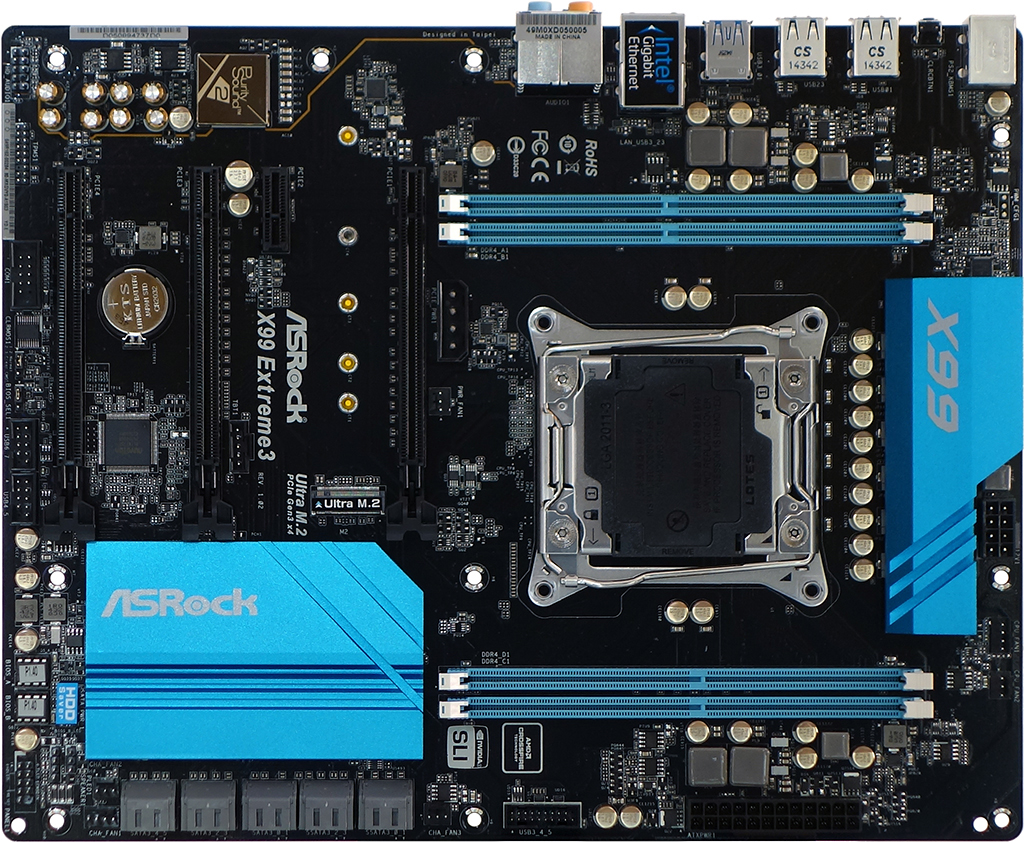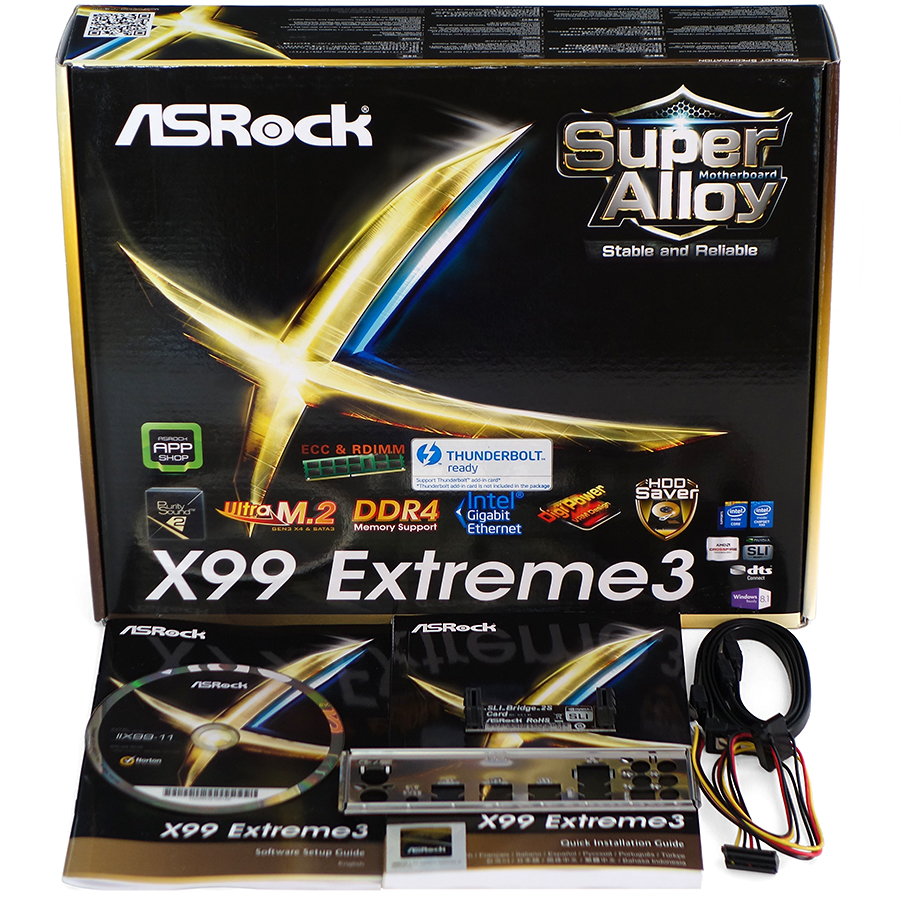ASRock X99 Extreme3 Review
Why you can trust Tom's Hardware
X99 Extreme3 Layout
ASRock cuts the X99 Extreme3’s cost in places that many value-seekers won’t notice or care much about, such as the inclusion of only four memory slots and no PCIe pathway switches. But that second point brings us to the third catch when it comes to building with the Core i7-5820K: it only has 28 PCIe 3.0 lanes, and the lack of pathway switches leaves the top slot stuck in x16 mode. Dropping the center slot to eight lanes at the CPU level, there are only four PCIe 3.0 lanes left. And without even more pathway switches, ASRock dedicates all four of those lanes permanently to the Ultra M.2 interface.

That means the third slot is just a tag-along, using half of the lanes from the X99 PCH’s PCIe 2.0 controller. Four lanes on a x16 slot isn’t enough to extract full performance from a modern graphics card, yet the firm still calls the X99 Extreme3 a three-way CrossFire-capable board. Nvidia wisely limits the X99 Extreme3 to two-card arrays. ASRock banks on the notion that value-oriented buyers won’t need three-way SLI, and it’s probably right. On the other hand, we’d hate for an unwary builder to make the mistake of thinking the board must support at least three-way SLI after seeing the term “Quad SLI” in marketing literature. “Quad” refers exclusively to two dual-GPU cards.
Second in marketing value to the Ultra M.2 slot that budget-minded builders probably won’t use, the X99 Extreme3’s socket-mounted dual-BIOS is the biggest feature that they might want to take advantage of. ASRock completely dodges its competitors' auto-switching issues by using a jumper to select between firmware one and two, adds an LED next to each IC to let you know which one is active and even sells replacement ICs to anyone determined to corrupt both ROMs.
ASRock was first to implement Intel’s USB 3.0 front-panel header (way back when it was still a proposal), and still dignifies the standard by placing it front-and-center where it won't conflict with any expansion cards. Additional conflicts are avoided by pointing all ten SATA connectors forward, leaving only the front-panel audio and USB 2.0 cables to interfere with a third graphics card. Not that most people would want a graphics card in the third x16 slot anyway.
The front-panel HD Audio connector is found all the way in the back corner, about an inch too far back for the cables of some cases. That'd really be the case manufacturer's fault though, since Intel specified this location back when it was called (with some pin definition differences) AC'97. Fan connectors are spread out more conveniently, with the X99 Extreme3 sporting two four-pin (PWM) and four three-pin interfaces.

In considering the enthusiast market, the X99 Extreme3’s biggest weakness might be its inclusion of only two SATA cables. The added PCIe two-drive power cable is a nice touch, though, as it connects to the motherboard to allow a remote power-on feature called ASRock HDD Saver.
X99 Extreme3 buyers also get a two-card SLI bridge.
Current page: X99 Extreme3 Layout
Prev Page Technical Specifications Next Page X99 Extreme3 Software And FirmwareGet Tom's Hardware's best news and in-depth reviews, straight to your inbox.
-
chenw In the 3D games benchmarks, you have CPU labeled as i7-4790k.Reply
Unless I completely missed something, that is a typo, 4790k cannot be paired with a X99 motherboard. -
chenw In the 3D games benchmarks, you have CPU labeled as i7-4790k.Reply
Unless I completely missed something, that is a typo, 4790k cannot be paired with a X99 motherboard. -
Crashman Reply15763410 said:In the 3D games benchmarks, you have CPU labeled as i7-4790k.
Unless I completely missed something, that is a typo, 4790k cannot be paired with a X99 motherboard.
Recycled charts, it could take a while to replace the typo version with the corrected version. Thanks for pointing this out.
15763411 said:In the 3D games benchmarks, you have CPU labeled as i7-4790k.
Unless I completely missed something, that is a typo, 4790k cannot be paired with a X99 motherboard.
Recycled charts, it could take a while to replace the typo version with the corrected version. Thanks for pointing this out.
-
PaulBags As I understand most current single graphics cards run fine at pcie3 8x, so staying sans switches and running perminantly at 8x/8x/8x +M.2 4x would have been an interesting option. Ah well.Reply -
Larry Litmanen As we all know some (if not all) Apple laptops come without a CD drive, some do not have a Ethernet jack (WiFi only), obviously everyone heard about the new laptop with USB 3.1 being the only jack on the laptop.Reply
I am not saying Intel and motherboard manufacturers need to go to that extreme, but we have reached a point where removing some of these old ports will allow manufacturers to save money and pass them to the buyer.
Is there really a need for a PS/2 port on a performance motherboard? Why not remove all the USB 2.0 ports and maybe add 2 more USB 3.0 ports.
I recently purchased a MSI motherboards called GAMING 5, it is a gaming motherboard (duhh), marketed towards people on the gaming/performance side. Obviously anyone buying this board in the retail store is buying it with an intent to play games, and almost no one who games in 2015 uses a VGA or DVI ports, it also has PS/2 port.
I am paying for these useless features that regular people almost no longer use, let alone gamers or people who are into PC building. You can include a HDMI to VGA or DVI adapter just in case someone out there still needs them.
I think they need to start removing some of the legacy ports and chips and make boards cleaner, cheaper and more affordable to manufacture and buy.
-
firefoxx04 Sigh.. I know that in order to make things cheaper you need to compromise but only 4 ram slots for an X99 platform? To me, a big reason to go X99 is the idea that I can run LOTS of ram. What is the point of going X99 if you only want the lower end 6 core with less PCIe lanes and only 4 ram slots?Reply
Call me crazy or missing the point but I would almost rather save even more and just stick with Z97. -
ShermOR It's not time to be buying. We need X99 & Z97 motherboards with NVMe enabled EUFI BIOS, USB 3.1 Type A & C front and rear & bootable NVMe M.2 3.0 4X . No MB's or cases support all these specs now.Reply -
mapesdhs Hmm, not keen on a top-end board without a debug post LED.Reply
Btw, Filippo's SLI article implies 3-way SLI at x8/x4/x4 would likely work,
since his tests showed no limitations with 2-way at x8/x8, but of course
NV doesn't support it. See the section entitled, "How Many PCIe Lanes
Do You Need?".
Ian.
-
logainofhades This board, to me, would only be useful for a non overclocking workstation rig, that doesn't need more than 32gb of ram. Otherwise, spend a little more and get at least the extreme 4.Reply
Edit* After looking at the prices on PCpartpicker, this board is pointless, unless it becomes much cheaper.
PCPartPicker part list / Price breakdown by merchant
Motherboard: ASRock X99 Extreme3 ATX LGA2011-3 Motherboard ($174.99 @ SuperBiiz)
Total: $174.99
Prices include shipping, taxes, and discounts when availableGenerated by PCPartPicker 2015-04-28 13:52 EDT-0400
PCPartPicker part list / Price breakdown by merchant
Motherboard: ASRock X99 Extreme4 ATX LGA2011-3 Motherboard ($192.98 @ Newegg)
Total: $192.98
Prices include shipping, taxes, and discounts when availableGenerated by PCPartPicker 2015-04-28 13:53 EDT-0400
I really hope the MSI X99S SLI Plus gets reviewed soon. It looks to be a promising budget board for X99. -
Larry Litmanen ReplyIt's not time to be buying. We need X99 & Z97 motherboards with NVMe enabled EUFI BIOS, USB 3.1 Type A & C front and rear & bootable NVMe M.2 3.0 4X . No MB's or cases support all these specs now.
That will be a very expensive system, life is too short to wait until all that hits the market and becomes somewhat affordable.
